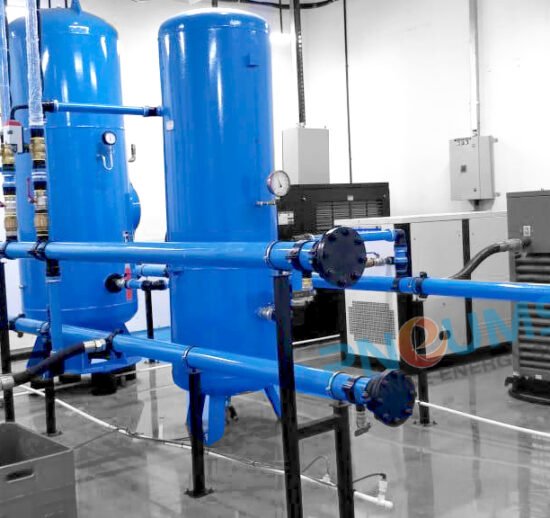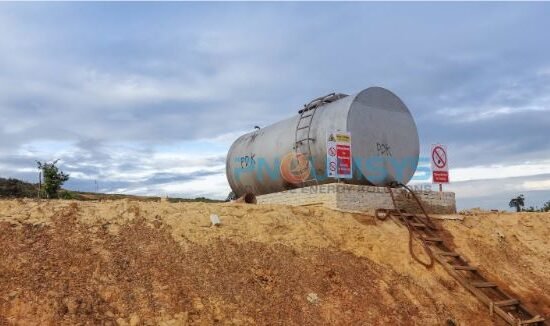To meet the needs, PNEUMSYS ADVANCE ENERGY SOLUTIONS (PAES) simplifies the process by providing a solution with an ammonia tank and system installation for industrial applications.
To brief you, for the installation procedure for the industrial applications, we would:
- On tanks, we would begin by installing self-closing valves or quick-turning ball valves. As a result, these valves serve as an emergency stop valve, preventing an ammonia release if the operator emptying oil from the valve becomes overwhelmed or must depart the workstation.
- The next stage is to install barriers or implement safety protocols to safeguard refrigerated equipment (e.g., pipes, valves, evaporator coils, tanks, vessels) that is susceptible to damage from forklifts, hand trucks, or other maintenance.
- Installing ammonia detectors to aid in the detection of leaks in anhydrous ammonia systems.
- We conduct the installation process with manually checking the valve in the ammonia charging line in a location close to the main control valve. In such a case, our prime focus is to isolate problems connected with the main control valve and prevent the release or removal of ammonia through the charging line.
- Install dual pressure relief valves (PRVs) to improve the maintenance of relief valves and we make sure each valve is the right size to protect the refrigeration equipment.
- In bigger systems that require several pressure relief valves, we consider employing PRVs and installing a ruptured disc upstream of each PRV with a gauge port or transducer in between the disc and the PRV, as well as installing an ammonia sensor in the PRV common manifold.
- Install switches for emergency ventilation. For a better experience, we employ remote switches that are close to, but safe from, the compressor room.
- To ensure that your facility’s engineering drawings or pipe and instrumentation diagrams are up to date, use a color-coding and/or labeling system. This decreases the possibility of errors in operational procedures.
BASIC RULES
CONTAINER CONSTRUCTION AND ORIGINAL TEST REQUIREMENTS state that the containers will be built and tested in accordance with the unfired pressure vessel code.
MARKING ON Ammonia tank storage containers:
Each storage tank must be clearly labeled as follows:
- Code certification
- The shell’s thickness in inches
- Head thickness measured in inches
- Outside diameter and overall length in inches
- Capacity in gallons of water
- Work pressure design
- Manufacturing date
- The serial number
For safety consideration, each bulk storage tank will be marked on at least two sides with the words “Anhydrous Ammonia – DANGEROUS OR CAUTION” in white letters not less than 6 inches high on a red background or the reverse.
In addition the warning signs “No smoking or Open Flame – Allowed”.
Consequently, all storage containers are equipped with an approved liquid level gauging device so that the maximum volume of a container filled by liquid shall not exceed 85% of its water capacity.
Moreover, all valves and accessory equipment are constructed of steel or other material approved for use with anhydrous ammonia. But, it is forbidden to use copper or any of its alloys for ammonia equipment.
Furthermore, excess flow valves or back pressure check valves must be installed inside the container or at a point outside where the line enters the container.
If fitted as in the latter situation, any extreme strain beyond the excess flow valve or back pressure check valve must not cause damage between the container and such valve.
The piping solution, Tubing, And Fittings
All fittings subjected to tank pressure will necessitate particularly heavy construction, with only steel (no copper steel), no cast iron, bushings, or plugs permitted in the lines or connections.
Galvanized pipe is not permitted to be used as ammonia line pipe for design purposes, although screwed and bolted flange joints are permitted with double strength pipe treated with glycerin for durability.
In the foreground, all pipelines must be laid as nearly straight as possible with the least quantity of pipe and without being constrained by an excessive number of elbows and bends.
When nipples are utilized, they must be exceptionally hefty and seamless. On permanently fixed installations, flexible connections are not permitted; rigid connections are necessary.
A few provisions will also be made to adequately protect all exposed piping from mechanical injury caused by moving machinery, the presence of automobiles or trucks, or any other undue strain placed on the piping.
After assembly, all piping and tubing must be tested at high pressure to ensure that it is leak-free. Before the system is put into service, the installer must perform and certify such tests.
Therefore, we have our man force trained, who could work efficiently to follow exact procedures.
As a result, we have trained our workforce to work efficiently while adhering to strict procedures.





